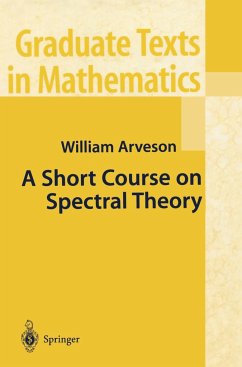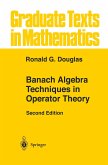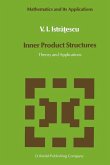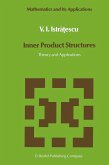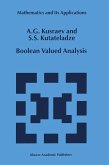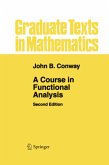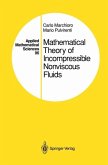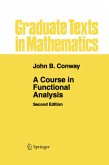This book presents the basic tools of modern analysis within the context of what might be called the fundamental problem of operator theory: to calculate spectra of specific operators on infinite-dimensional spaces, especially operators on Hilbert spaces. The tools are diverse, and they provide the basis for more refined methods that allow one to approach problems that go well beyond the computation of spectra; the mathematical foundations of quantum physics, noncommutative K-theory, and the classification of simple C-algebras being three areas of current research activity that require mastery of the material presented here. The notion of spectrum of an operator is based on the more abstract notion of the spectrum of an element of a complex Banach algebra. After working out these fundamentals we turn to more concrete problems of computing spectra of operators of various types. For normal operators, this amounts to a treatment of the spectral theorem. Integral operators require 2 the development of the Riesz theory of compact operators and the ideal L of Hilbert-Schmidt operators. Toeplitz operators require several important tools; in order to calculate the spectra of Toeplitz operators with continuous symbol one needs to know the theory of Fredholm operators and index, the ? structure of the Toeplitz C-algebra and its connection with the topology of curves, and the index theorem for continuous symbols.
From the reviews:
MATHEMATICAL REVIEWS
"This book, a product of the author's own graduate courses on spectral theory, offers readers an expert and informed treatment of the major aspects of the spectral theory of Hilbert space operators. It is evident that a great deal of thought has gone into the choice of topics, the presentation of the results, and the design of exercises. The text is clearly written and the material is motivated in a fashion that a newcomer to the subject can readily understand...Graduate students and experienced mathematicians alike will enjoy and benefit from a close reading of this well-written book."
"I find that Arvesen's book is a fine addition to the existing literature. Each section has several interesting, doable exercises. Arvesen tells us that the book is based on graduate courses taught at Berkeley to first and second year PhD students. In Europe, it should be possible to teach parts of the book (e.g. chapters 1 and 3) to studentsat the Master level." (Alain Valette, Bulletin of the Belgian Mathematical Society, Vol. 12 (1), 2005)
"The book is written in an easily readable style, the composition is clear, many examples and a great number of exercises help the reader in understanding the material." (Endre Durszt, Acta Scientiarum Mathematicarum, Vol. 69, 2003)
"This book ... offers readers an expert and informed treatment of the major aspects of the spectral theory of Hilbert space operators. It is evident that a great deal of thought has gone into the choice of topics, the presentation of the results, and the design of exercises. The text is clearly written and the material is motivated in a fashion that newcomers to the subject can readily understand. ... Graduate students and experienced mathematicians alike will enjoy and benefit from ... this well-written book." (Douglas R. Farenick, Mathematical Reviews, Issue 2001 j)
"I used (part of) the book last year for a small class ... at UNSW, and it eased the task of writing the lectures considerably. ... This is very much a book written for students. There are lots of nice examples and informative exercises. ... I was quite struck by the number of places where the writing provided me with new insights. ... this book is highly recommended for anyone ... who wants to acquire some of the basic tools of modern analysis." (Ian Doust, The Australian Mathematical Society Gazette, Vol. 30 (3), 2003)
"The aim of the present book ... is to make the reader acquainted with the basic results in spectral theory, needed for the study of more advanced topics ... . The book is a clear, short and thorough introduction to spectral theory, accessible to first and or second year graduate students. As the author points out in the Preface: 'this material is the essential beginning for any serious student in modern analysis'." (S. Cobzas, Studia Universitatis Babes-Bolyai Mathematica, Vol. XLVII (4), 2002)
"In this book the basic toolsof modern operator theory are presented. The notion of a spectrum of an operator is treated with the more abstract notion of spectrum of an element of a complex Banach algebra. ... Each part of the book contains interesting exercises, which give many new insights into further developments and enhance the usefulness of the book." (F. Haslinger, Monatshefte für Mathematik, Vol. 138 (3), 2003)
"The book is well-written and provides a large variety of results, ranging from the historical roots to the frontiers of contemporary research. ... the book may be of interest for those who have already got in touch with classical spectral theory during a course on functional analysis and operator theory, and want to learn something about the interconnections of spectra with abstract fields like C*-algebras or modern K-theory." (Jürgen Appell, Zentralblatt MATH, Vol. 997 (22), 2002)
"This is a nicely written textbook which can be recommended to every student of modern analysis. The text,already lively, additionally gains through a lot of exposed Remarks. Further, any section contains a lot of Exercises (together nearly 175) ... for which sometimes hints are given." (J. Synnatzschke, Zeitschrift für Analysis und ihre Anwendungen, Vol. 21 (2), 2002)
"Presents a tightly structured whole, fitted into an orbit of around 130 pages, and provides the reader with 'many deep and important ideas [that] emerge in natural ways.' ... Little more needs to be said about this excellent book: it has plenty of good exercises, it is well written, and reaps the benefit of coming from the author's experience with this important material in his graduate courses at Berkeley. It is indeed a very good textbook in a fundamental and centrally important subject." (Michael Berg, The Mathematical Association of America, May, 2012)
MATHEMATICAL REVIEWS
"This book, a product of the author's own graduate courses on spectral theory, offers readers an expert and informed treatment of the major aspects of the spectral theory of Hilbert space operators. It is evident that a great deal of thought has gone into the choice of topics, the presentation of the results, and the design of exercises. The text is clearly written and the material is motivated in a fashion that a newcomer to the subject can readily understand...Graduate students and experienced mathematicians alike will enjoy and benefit from a close reading of this well-written book."
"I find that Arvesen's book is a fine addition to the existing literature. Each section has several interesting, doable exercises. Arvesen tells us that the book is based on graduate courses taught at Berkeley to first and second year PhD students. In Europe, it should be possible to teach parts of the book (e.g. chapters 1 and 3) to studentsat the Master level." (Alain Valette, Bulletin of the Belgian Mathematical Society, Vol. 12 (1), 2005)
"The book is written in an easily readable style, the composition is clear, many examples and a great number of exercises help the reader in understanding the material." (Endre Durszt, Acta Scientiarum Mathematicarum, Vol. 69, 2003)
"This book ... offers readers an expert and informed treatment of the major aspects of the spectral theory of Hilbert space operators. It is evident that a great deal of thought has gone into the choice of topics, the presentation of the results, and the design of exercises. The text is clearly written and the material is motivated in a fashion that newcomers to the subject can readily understand. ... Graduate students and experienced mathematicians alike will enjoy and benefit from ... this well-written book." (Douglas R. Farenick, Mathematical Reviews, Issue 2001 j)
"I used (part of) the book last year for a small class ... at UNSW, and it eased the task of writing the lectures considerably. ... This is very much a book written for students. There are lots of nice examples and informative exercises. ... I was quite struck by the number of places where the writing provided me with new insights. ... this book is highly recommended for anyone ... who wants to acquire some of the basic tools of modern analysis." (Ian Doust, The Australian Mathematical Society Gazette, Vol. 30 (3), 2003)
"The aim of the present book ... is to make the reader acquainted with the basic results in spectral theory, needed for the study of more advanced topics ... . The book is a clear, short and thorough introduction to spectral theory, accessible to first and or second year graduate students. As the author points out in the Preface: 'this material is the essential beginning for any serious student in modern analysis'." (S. Cobzas, Studia Universitatis Babes-Bolyai Mathematica, Vol. XLVII (4), 2002)
"In this book the basic toolsof modern operator theory are presented. The notion of a spectrum of an operator is treated with the more abstract notion of spectrum of an element of a complex Banach algebra. ... Each part of the book contains interesting exercises, which give many new insights into further developments and enhance the usefulness of the book." (F. Haslinger, Monatshefte für Mathematik, Vol. 138 (3), 2003)
"The book is well-written and provides a large variety of results, ranging from the historical roots to the frontiers of contemporary research. ... the book may be of interest for those who have already got in touch with classical spectral theory during a course on functional analysis and operator theory, and want to learn something about the interconnections of spectra with abstract fields like C*-algebras or modern K-theory." (Jürgen Appell, Zentralblatt MATH, Vol. 997 (22), 2002)
"This is a nicely written textbook which can be recommended to every student of modern analysis. The text,already lively, additionally gains through a lot of exposed Remarks. Further, any section contains a lot of Exercises (together nearly 175) ... for which sometimes hints are given." (J. Synnatzschke, Zeitschrift für Analysis und ihre Anwendungen, Vol. 21 (2), 2002)
"Presents a tightly structured whole, fitted into an orbit of around 130 pages, and provides the reader with 'many deep and important ideas [that] emerge in natural ways.' ... Little more needs to be said about this excellent book: it has plenty of good exercises, it is well written, and reaps the benefit of coming from the author's experience with this important material in his graduate courses at Berkeley. It is indeed a very good textbook in a fundamental and centrally important subject." (Michael Berg, The Mathematical Association of America, May, 2012)

